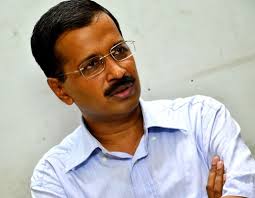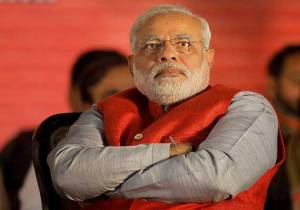Yes it’s a simplistic dichotomy, but there is really no better way to describe the current Delhi elections. On the one hand, a little ragtag army of Davids behind “Mufflerman”, as his faithful supporters affectionately call him, a person in baggy sweater and sneakers, one you wouldn’t look at twice if you passed him on the road.


On the other hand, a massively funded, aggressively confident Goliath, openly backed by the corporate bodies and full-page ads, riding a national “Wave” higher than most Tsunamis, topped by the 56-inch chest of “Modiman”, even if recently modestly covered by a 12-lakh rupee vest.


On the one hand, a fearful and awed media establishment donating PR for free to the seemingly invincible King of Gujarat, and on the other, an aam aadmi, a volunteer-cadre run campaign and a palpable vibe of trust and openness on the ground. I know I know, some will say it’s all ‘perception management’ and PR, but barring the googly of the 2 crores party donation thrown at the opportune moment, if Mufflerman’s party was any cleaner, it could have given Lalita ji’s Surf a run for its money. Whatever the result on the 10th (and there is reason to be hawk-eyed about the possibility of tampering as Nivedita Menon’s post has urged), how does anybody not get what a miracle this alone is, in a political economy with a black economy of a size that is higher than the GDPs of most smaller countries? Perhaps this is in fact about hope and fear after all, however clichéd that sounds.
Hope is what has sustained the AAP campaign until now, one which has begun to look more and more concrete as the results draw closer. It is fear too that I am thinking about, when considering elections again, on a much more humble scale – at the level of the University. Delhi University teachers just voted to elect officials for the Academic Council and Executive Council of the University – statutory bodies of the University that are in clear and present danger of being dissolved if the Knowledge-Industrial Complex has its way in the near future. For they function on the increasingly archaic-looking principle of workplace democracy – a principle that nobody seems to really understand, leave alone support. Much more convenient to simply empower the VC to take all decisions. Which would be wonderful if the VC had descended from heaven, solution in hand for the myriad plagues of our vast and complex universities, just as we hoped Modiman could offer to a nation of 1.2 billion. But the inconvenience is this: the number of scandals involving past VCs – charges of plagiarism, unsafe research conditions (and by unsafe I mean radiation-in-the-chemistry-lab-level unsafe!), shielding sexual offenders, silencing any inconvenient voices, the list is sordid and long…should be enough to wonder if this office is seriously compromised. More importantly, we should wonder further if that actually is the plan, dumbed down and compliant universities topped by bullies, so when in doubt, appoint a retired army general or naval chief as VC, as many especially minority institutions have had the grand luck to recently experience. Attention!! Learning!! March Past!!
None of this should surprise us of course. This is a country that spends an abysmal 3.6% of our GDP on education, (below not only almost all the developed countries with the exception of Singapore) and our arch rival China (which has since the 1950s provided a nine-year compulsory school education to a fifth of the world’s population, apart from supporting an expanding list of top class universities) but also below countries like Burkina Faso, Samoa and Saudi Arabia. The low spending on education has remained constant, like Brahma himself, while other political and economic indicators have swung wildly from this corner to that. Neither Nehruvian “socialism” nor Modi-ist “development” have found place for education, for hiring and training teachers, for infrastructure, for equity and access, for even real merit or quality which is supposedly the hallmark of a market system. So teaching increasingly attracts either the very privileged, or those with no other options, creating a swelling reserve army of footloose adjunct faculty across the country and a field day for authorities who would always prefer a vulnerable employee to one who has secure employment and a chance to assess her situation. The link between tenure and academic freedom has been recognised and pursued since at least 1940 by University Professors in the U.S. What is amazing is that the conversation hasn’t even started here.
Take the entry qualifications for university teachers – either an almost comically arbitrary examination called the National Entrance Test (NET) or a PhD. The NET examination is possibly the only examination in India that a genuinely talented scholar is embarrassed of passing – so inexplicable are its questions, and so random are its results. With an average pass percentage of less than 10%, the thousands who don’t qualify must enrol in one of a tiny handful of decent universities for a PhD. This in itself would be no problem at all of course. But what awaits these PhDs at the end of years of research on meagre research grants and practically no infrastructure? At a recent interview for permanent posts in a college in Delhi University, 200 candidates were interviewed for 8 posts! Nearly half of them – a hundred – had PhDs from good universities. Ok, NET is exempted for teachers in some of the better private universities that have been set up recently. But the catch is that while you don’t need a NET, you probably don’t stand a chance without a foreign PhD. By foreign is meant from one of the recognised First World universities. So where do these thousands of Indian PhDs go, after years spent preparing for an academic career?
Back to the public universities, where an absolute epidemic of contractualisation combined with stressful working and service conditions including no possibility of promotions, leave alone pension, leave and medical benefits has meant a pervasive culture of fear and self-censorship amongst faculty members. Staff associations – teachers’ unions – where they exist, are demonised – the current Delhi University VC famously denounced them as illegal bodies that were made up by the teachers themselves. Yes, Sir, that is because you or your predecessors were not going to make a union for us in any hurry! There is a widely-felt sense that surveillance – both formal and informal – is on the rise, that colleagues are ratting on each other to authorities, and that classrooms and tutorials are being watched for any signs of anti-establishment talk. One visible result is the construction of the good teacher as one who is intellectually self-effacing, competent without being brilliant or charismatic, and ultimately a conformist. This of course has long term consequences for that other archaic thing that apparently research can’t do without – freedom of thought and ideas. Ramachandra Guha’s recent article points to the damaging absence of a genuine research culture in India, in the midst of what he terms the staggering vanity of the powerful in academia. I am reminded of the VC’s infamous arrival on an elephant for an annual cultural “fest” at Delhi University a couple of years ago. From that height, his colleagues who ‘simply’ teach and go about their daily lives must have looked really small and inconsequential.
The vanity of the powerful is only matched by the mousiness of the not-powerful. Recently, Spiked Magazine published the results of a survey of universities in the U.K, and concluded that more than half were in serious danger of becoming anti-free speech zones. This survey is itself controversial, since it argues against student unions policing speech in order to rule out fascist, sexist or other extremist views. It is arguable that these views do need policing in fact, even if of the mildest and most self-regulated form. However, what is at stake at universities worldwide is the freedom of various members including teachers to speak without fear, and it is such a survey that Spiked’s survey indirectly points to the need for. One surprising – perhaps not so surprising – finding is that the more elite and better funded universities fare worse on free speech norms.
The only reason this country still functions is because we have a high tolerance for collateral damage as a society. Long before the Americans introduced the euphemism to the global vocabulary by carpet-bombing parts of Afghanistan and Iraq, Indians already knew that shoving our way to the top without looking down or back is the way to go. But maybe Perhaps Mufflerman is a powerful portent. As I have been writing this post, the exit polls have predicted a big edge for Mufflerman, and Abha Dev Habib of the Left-oriented Democratic Teachers’ Front – a classic teachers’ union of the old style – has won in the election at Delhi University, giving us another day to fight on. If we have chosen the daily humdrum right to take decisions in the workplace and the city over shiny vests and chests and the always-receding horizon of development, we have chosen hope over fear. Hail the humble Muffler!
Photo Credits: Business Standard, Suffragio.org, Twitter.

Would you concede that BJP is atleast honest in this election, if AAP wins? atleast with regards to EVMs, that BJP did not tamper? will you say that with the same enthusiasm in your blogs that BJP did not tamper EVMs? or will you say they tampered in the places they won?
LikeLike
Dear Notanotherjerk, clearly these are rhetorical questions, but I will take the risk of answering them! If there is no tampering, there is no tampering. If there is tampering, there is tampering. The Election Commission needs to probe every allegation, since it is of a serious nature. We in the media need to report every such allegation and subsequent probe. Matter ends.
LikeLike
Just a small comment on your statement “this is a country that spends an abysmal 3.1% of our GDP on education, (below not only almost all the developed countries with the exception of Singapore) ”
The citation is dated, it reports the expenditure in 2006, that is 9 years ago. As per the most recent data available, India’s total budgetary expenditure on education is 4.6% and total public expenditure on education as a percentage of the GDP is 3.5%.
http://164.100.47.134/intranet/BUDGET.pdf (Yes, as questionable as Wikipedia but I’ll take my chances)
Of course, this is a very very minor point – your larger argument is completely valid.
LikeLike
Dear Fellow Elsa, thanks for pointing that out. I stand corrected. So yes, I wanted to speak of spending as a proportion of GDP. What amazes me is that if it’s 3.5% now, it’s only up 0.4 % from 9 years ago!! The recommendation for a sustainable basic minimum is around 6% right? By the way, don’t you hate the term “ELSA”?!
LikeLike
http://www.livemint.com/Opinion/nGSKg6jktJpuF4gEaZ3HkL/Drifting-to-teaching.html
Sadly, applies almost word to word to University teaching.
LikeLike
“s, topped by the 56-inch chest of “Modiman”, even if recently modestly covered by a 12-lakh rupee vest.”
Toi and Timesnow have apologized for the error.and they quoted it to be 10 lakhs only. moderate all you want. but if you are passionate for truth. you might want check on that. once in a while its nice to back truth with proof
LikeLike
Ohhh sorry! If its 10 lakhs “only” that makes a big difference to my argument…
Also, just to be fair, where is the proof at your end? Indeed, if we are going by statements, a BJP spokesperson on NDTV has said it’s 7,000 rupees only. I really want a suit stitched at this place man.
LikeLike